考研英语必备时态语法全突破
考研英语必备时态[考研究专题]
![考研英语必备时态[考研究专题]](https://img.taocdn.com/s3/m/a12a44b9294ac850ad02de80d4d8d15abf230054.png)
考研英语必备:时态、语法全突破一、时态、语态时态、语态需要掌握的要点:1.以下几类动词一般不能用于进行时,同样不用于完成进行时:(1)表示感知的动词:hear, feel, notice, recognize, see, taste, smell;(2)表示意愿、情感的动词:desire, dislike, forgive, hate, like, love, prefer, refuse, want, wish, fear, love, hate;(3)表示思考、看法的动词:believe, doubt, expect, forget, hope, feel, mean, know, agree, realize, mind, recall, recollect, remember, trust, suppose;(4)表示所有、占有的动词:belong to, owe, own, possess, hold(容纳);(5)其他动词:cost, appear, concern, contain, consist, deserve, matter, seem。
如:I’d s ay whenever you are going after something that is belonging to you, anyone who is depriving you of the right to have it is criminal.(1997年考研题,belong表示归属,不用于进行式)He was seeing somebody creeping into the house through the open window last night.(1990年考研题,see表示结果,不用于进行式)2. 不用will/shall表达将来时的形式:(1)be going to表示现在的打算和意图;(2)arrive, come, drive, go, leave, retire, return, set off, start, take off等表示移位的动词的进行体表示按计划肯定要发生的将来动作;(3)be to (do)表示安排、计划、决定、命令或注定要发生的事,如:Greater efforts to increase agricultural production must be made if food shortage is to be avoided.(4)be about to (do)表示将要(做),如:Marlin is a young man of independent thinking who is not about to pay compliments to his political leaders.(5)be on the point /verge of (doing)表示“马上就要”,一般不与表示将来的时间状语连用;(6)be, begin, come, depart, get off, go, leave, return, start的一般现在时表示按日历或时刻表要发生的将来动作或事件,如:If you want your film to be properly processed, you’ll have to wait and pick it up on Friday, which is the day after tomorrow.(画线部分一般不用will be)(7)在时间、条件、让步从句中,一般现在时代替将来时,但要注意区别从句的类型,如:I don’t know where he will go tomorrow. 我不知道他明天去哪儿。
考研英语语法攻略:必知的语法点

考研英语语法攻略:必知的语法点考研英语语法攻略:必知的语法点作为考研英语的重要部分,语法是很多考生感到困难和头痛的一点。
然而,语法是英语的基础,只有掌握了英语语法,才能更好地掌握英语语言的核心。
在考研英语中,语法作为基础环节,任何一道题目都有可能涉及到语法问题。
因此,掌握必要的语法点是考研英语的必备技能。
下面,我们将介绍一些必知的考研英语语法点,帮助考生更好地备考。
一、时态时态是英语语法中最基本的部分,它指的是某一动作或状态在时间上的表达。
英语语法中有12种时态,包括现在时态、过去时态、将来时态以及它们的完成形式。
在考研英语中,出题人往往会利用时态来测试考生对语法的掌握程度。
二、主谓一致主谓一致是指主语和谓语在数量上保持一致。
例如,“The book is on the table”中,“book”作为单数主语,谓语“is”也应该使用单数形式。
在考研英语中,主谓一致的错误率很高,因此考生需要格外注意。
三、从句在英语语法中,从句是指在一个句子中包含另一个完整的句子。
从句有许多种类,包括定语从句、状语从句、宾语从句等。
从句的使用对英语句子的结构非常重要,在考研英语中也经常出现。
四、虚拟语气虚拟语气指非真实情况下所使用的语态。
虚拟语气中常见的包括与现在事实相反的虚拟语气和与过去事实相反的虚拟语气。
虚拟语气需要考生掌握,因为在考研英语中,出题人往往会利用虚拟语气来测试考生的语法知识。
五、倒装倒装句是指把谓语动词放在主语前面。
倒装句的常见形式有完全倒装和部分倒装。
在考研英语中,倒装也是常见的考点,考生需要熟练掌握,正确地运用倒装。
六、非谓语动词非谓语动词通常指不带有人称和时态变化的动词形式。
英语中的非谓语动词包括不定式、动名词和分词等。
在考研英语中,非谓语动词经常被用来测试考生的语法知识。
七、关系代词关系代词是连接主句和从句的代词,包括who、whom、whose、which和that等。
在考研英语中,关系代词常常被使用在定语从句中,要求考生根据句子的结构和意思正确选择合适的关系代词。
英语语法大全之16种时态的深入解析

英语语法大全之16种时态的深入解析1. 现在时 (Present Simple)- 主要用于表达惯性、普遍性的动作或状态。
- 结构:主语 + 动词原形 (+ 其他附加成分)。
- 例句:He watches TV every evening.2. 过去时 (Past Simple)- 主要用于过去发生的动作或状态。
- 结构:主语 + 动词过去式 (+ 其他附加成分)。
- 例句:She visited her grandparents last weekend.3. 将来时 (Future Simple)- 主要用于表示将来发生的动作或状态。
- 结构:主语 + will + 动词原形 (+ 其他附加成分)。
- 例句:They will go to the park tomorrow.4. 现在进行时 (Present Continuous)- 主要用于表示现在正在进行的动作。
- 结构:主语 + am/is/are + 现在分词 (+ 其他附加成分)。
- 例句:I am studying for the exam.5. 过去进行时 (Past Continuous)- 主要用于表示过去某个时间点正在进行的动作。
- 结构:主语 + was/were + 现在分词 (+ 其他附加成分)。
- 例句:She was sleeping when I arrived.6. 将来进行时 (Future Continuous)- 主要用于表示将来某个时间点正在进行的动作。
- 结构:主语 + will be + 现在分词 (+ 其他附加成分)。
- 例句:They will be working at the office tomorrow.7. 现在完成时 (Present Perfect)- 主要用于表示过去发生的动作对现在产生的影响。
- 结构:主语 + have/has + 过去分词 (+ 其他附加成分)。
- 例句:He has finished his homework.8. 过去完成时 (Past Perfect)- 主要用于表示过去某个时间点之前已经完成的动作。
考研英语语法总结经典版

考研英语语法总结经典版一、句子成分1.主语:句子中起名词或代词作用,通常位于句子的开头。
例:Tom likes to play basketball.(主语是Tom)2.谓语:句子中表示动作、状态或存在的部分,通常位于主语之后。
例:She is reading a book.(谓语是is reading)3.宾语:句子中接在动词后面的成分,回答“谁”或“什么”。
例:He bought a new car.(宾语是a new car)4.表语:句子中用来描述主语的成分,通常是形容词、名词或介词短语。
例:The weather is sunny.(表语是sunny)5.定语:句子中用来修饰名词或代词的成分,通常是形容词、数字、名词短语等。
例:The old man lives in the small house.(定语是the small house)6.状语:句子中用来修饰动词、形容词或副词的成分,通常是副词或介词短语。
例:She works hard.(状语是hard)7.同位语:句子中用来解释、说明或补充前面名词或代词的成分。
例:My best friend, Alice, is a doctor.(同位语是Alice)二、时态和语态1.时态:表示动作发生的时间或状态的时间。
-现在时:表示现在正在进行的动作或状态。
例:I am reading a book.-过去时:表示过去发生的动作或状态。
例:He bought a new car.-将来时:表示将来要发生的动作或状态。
例:I will go to the beach tomorrow.-过去完成时:表示过去一些时间之前已经完成的动作或状态。
例:She had finished her homework before dinner.2.语态:表示动作的主体和受体。
-主动语态:表示主语执行动作或状态。
例:He cleans the room every day.-被动语态:表示主语承受动作或状态。
史上最全的中考英语语法必考知识点大全
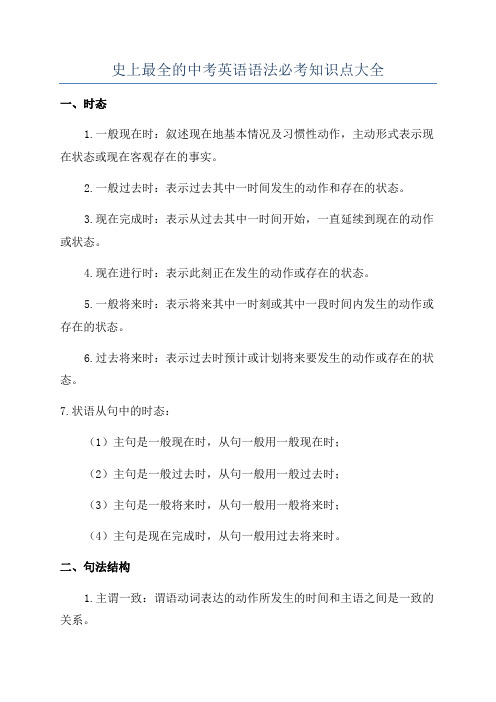
史上最全的中考英语语法必考知识点大全
一、时态
1.一般现在时:叙述现在地基本情况及习惯性动作,主动形式表示现在状态或现在客观存在的事实。
2.一般过去时:表示过去其中一时间发生的动作和存在的状态。
3.现在完成时:表示从过去其中一时间开始,一直延续到现在的动作或状态。
4.现在进行时:表示此刻正在发生的动作或存在的状态。
5.一般将来时:表示将来其中一时刻或其中一段时间内发生的动作或存在的状态。
6.过去将来时:表示过去时预计或计划将来要发生的动作或存在的状态。
7.状语从句中的时态:
(1)主句是一般现在时,从句一般用一般现在时;
(2)主句是一般过去时,从句一般用一般过去时;
(3)主句是一般将来时,从句一般用一般将来时;
(4)主句是现在完成时,从句一般用过去将来时。
二、句法结构
1.主谓一致:谓语动词表达的动作所发生的时间和主语之间是一致的关系。
2.主语从句:即用疑问词引导的从句,其主语在句中充当整个句子或者句子成分的主语。
3.主谓宾:即主语、谓语动词和宾语三部分的句子结构。
4.定语从句:即用关联词引导的附加句,其作用是对主句中的一些名词或代词进行补充说明。
5.宾语从句:即用从属连词引导的从句,其作用是把从句的内容作为宾语放在动词后面。
考研英语需要掌握些语法口诀
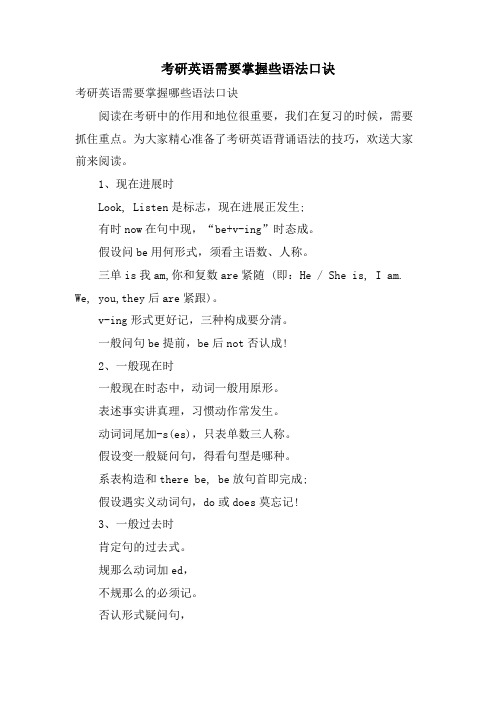
考研英语需要掌握些语法口诀考研英语需要掌握哪些语法口诀阅读在考研中的作用和地位很重要,我们在复习的时候,需要抓住重点。
为大家精心准备了考研英语背诵语法的技巧,欢送大家前来阅读。
1、现在进展时Look, Listen是标志,现在进展正发生;有时now在句中现,“be+v-ing”时态成。
假设问be用何形式,须看主语数、人称。
三单is我am,你和复数are紧随 (即:He / She is, I am. We, you,they后are紧跟)。
v-ing形式更好记,三种构成要分清。
一般问句be提前,be后not否认成!2、一般现在时一般现在时态中,动词一般用原形。
表述事实讲真理,习惯动作常发生。
动词词尾加-s(es),只表单数三人称。
假设变一般疑问句,得看句型是哪种。
系表构造和there be, be放句首即完成;假设遇实义动词句,do或does莫忘记!3、一般过去时肯定句的过去式。
规那么动词加ed,不规那么的必须记。
否认形式疑问句,没有be加did。
如把did加在前,动词还要归原形。
4、基数词变序数词基变序,很容易,一二三,特殊记,th从四起。
八去t来九去e,遇到ve,f替,ty变为tie,后加th莫迟疑,假设想表示几十几,只变个位就可以。
5、时间介词巧记歌年、月、季节前用in, (如:in xx, in September, in spring)日期前面行不通。
遇到几号或星期改用on来做代替, (如:on January 1,onWedesday)上午、下午、晚上仍用in。
(如:in themorning/afternoon/evening)假设是某日上下午,也是用on才能行。
(如:on theevening of the Mid-autumn Day)正午、夜里用at, (如:at noon, at night)时、分用法也同理。
(如:, at two, at two)如假设“差”点须加to, (如:two to two)如假设“过”点改past。
16种时态及语态总结
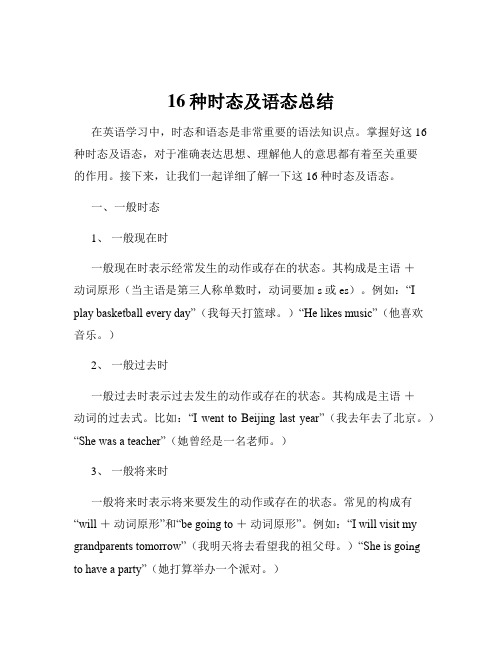
16种时态及语态总结在英语学习中,时态和语态是非常重要的语法知识点。
掌握好这 16 种时态及语态,对于准确表达思想、理解他人的意思都有着至关重要的作用。
接下来,让我们一起详细了解一下这 16 种时态及语态。
一、一般时态1、一般现在时一般现在时表示经常发生的动作或存在的状态。
其构成是主语+动词原形(当主语是第三人称单数时,动词要加 s 或 es)。
例如:“I play basketball every day”(我每天打篮球。
)“He likes music”(他喜欢音乐。
)2、一般过去时一般过去时表示过去发生的动作或存在的状态。
其构成是主语+动词的过去式。
比如:“I went to Beijing last year”(我去年去了北京。
)“She was a teacher”(她曾经是一名老师。
)3、一般将来时一般将来时表示将来要发生的动作或存在的状态。
常见的构成有“will +动词原形”和“be going to +动词原形”。
例如:“I will visit my grandparents tomorrow”(我明天将去看望我的祖父母。
)“She is goi ngto have a party”(她打算举办一个派对。
)二、进行时态1、现在进行时现在进行时表示现在正在进行的动作。
其构成是“be(am/is/are)+现在分词”。
例如:“I am reading a book now”(我现在正在读书。
)2、过去进行时过去进行时表示过去某个时刻正在进行的动作。
其构成是“was/were +现在分词”。
比如:“He was playing football at this time yesterday”(昨天这个时候他正在踢足球。
)3、将来进行时将来进行时表示将来某个时刻正在进行的动作。
其构成是“will be +现在分词”。
例如:“I will be studying English at 8 o'clock tomorrow evening”(明天晚上 8 点我将正在学习英语。
田静 考研英语常用时态

田静考研英语常用时态
田静是一位考研英语老师,她在教学中经常强调以下几种常用时态:
1. 一般现在时:用于描述客观事实、普遍真理、习惯性动作或状态等。
例如:The earth goes around the sun.(地球绕着太阳转。
)
2. 一般过去时:用于描述过去发生的事情或动作。
例如:I went to the park yesterday.(我昨天去了公园。
)
3. 现在进行时:用于描述正在进行的动作或状态。
例如:She is watching TV now.(她现在正在看电视。
)
4. 过去进行时:用于描述过去某个时间正在进行的动作。
例如:He was reading a book when I called him.(我给他打电话时,他正在看书。
)
5. 现在完成时:用于描述已经完成的动作对现在的影响或过去的动作持续到现在。
例如:I have finished my homework.(我已经完成了我的作业。
)
6. 过去完成时:用于描述过去某个时间之前已经完成的动作。
例如:He had left before
I arrived.(我到达之前,他已经离开了。
)
这些时态是考研英语中最基本、最常用的时态,掌握它们的用法对于理解和表达英语句子非常重要。
当然,在实际应用中,还需要根据具体语境和句子结构来选择合适的时态。
英语语法专项突破(动词的时态和语态)超实用,特别推荐
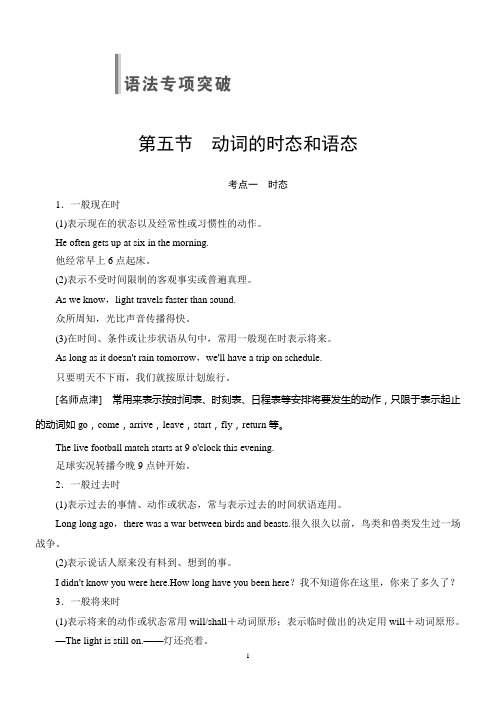
第五节动词的时态和语态考点一时态1.一般现在时(1)表示现在的状态以及经常性或习惯性的动作。
He often gets up at six in the morning.他经常早上6点起床。
(2)表示不受时间限制的客观事实或普遍真理。
As we know,light travels faster than sound.众所周知,光比声音传播得快。
(3)在时间、条件或让步状语从句中,常用一般现在时表示将来。
As long as it doesn't rain tomorrow,we'll have a trip on schedule.只要明天不下雨,我们就按原计划旅行。
[名师点津]常用来表示按时间表、时刻表、日程表等安排将要发生的动作,只限于表示起止的动词如go,come,arrive,leave,start,fly,return等。
The live football match starts at 9 o'clock this evening.足球实况转播今晚9点钟开始。
2.一般过去时(1)表示过去的事情、动作或状态,常与表示过去的时间状语连用。
Long long ago,there was a war between birds and beasts.很久很久以前,鸟类和兽类发生过一场战争。
(2)表示说话人原来没有料到、想到的事。
I didn't know you were here.How long have you been here?我不知道你在这里,你来了多久了?3.一般将来时(1)表示将来的动作或状态常用will/shall+动词原形;表示临时做出的决定用will+动词原形。
—The light is still on.——灯还亮着。
—Sorry,I'll go and turn it off.——很抱歉,我这就去关掉。
(2)be going to表示按计划、打算要做某事,此外,还可以表示根据现在的迹象对未来做出判断。
考研英语中的语法重点整理
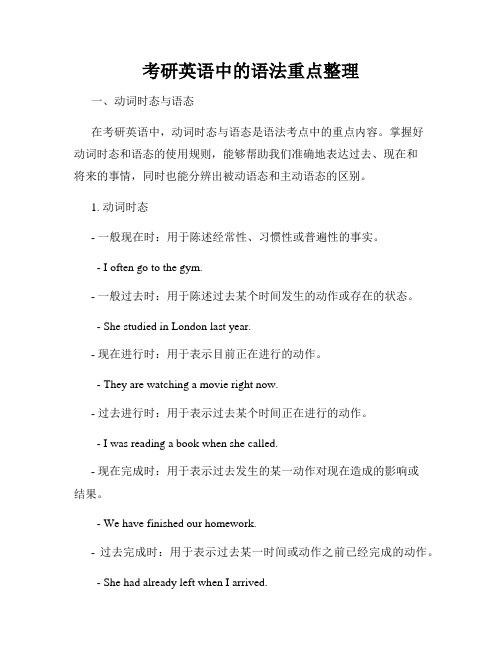
考研英语中的语法重点整理一、动词时态与语态在考研英语中,动词时态与语态是语法考点中的重点内容。
掌握好动词时态和语态的使用规则,能够帮助我们准确地表达过去、现在和将来的事情,同时也能分辨出被动语态和主动语态的区别。
1. 动词时态- 一般现在时:用于陈述经常性、习惯性或普遍性的事实。
- I often go to the gym.- 一般过去时:用于陈述过去某个时间发生的动作或存在的状态。
- She studied in London last year.- 现在进行时:用于表示目前正在进行的动作。
- They are watching a movie right now.- 过去进行时:用于表示过去某个时间正在进行的动作。
- I was reading a book when she called.- 现在完成时:用于表示过去发生的某一动作对现在造成的影响或结果。
- We have finished our homework.- 过去完成时:用于表示过去某一时间或动作之前已经完成的动作。
- She had already left when I arrived.2. 语态- 被动语态:指动作的承受者放在句子的主语位置,强调动作或状态的受事。
- The novel was written by a famous author.- 主动语态:指动作的执行者放在句子的主语位置,强调动作的执行者。
- The author wrote a novel.二、句子结构与语法填空句子结构与语法填空是考研英语中的另一个重要考点。
在这部分,我们要学习句子的基本结构以及如何进行语法填空。
1. 句子结构- 主谓结构:由主语和谓语构成的简单句结构。
- She works as a teacher.- 主谓宾结构:由主语、谓语和宾语构成的简单句结构。
- He bought a new car.- 主谓宾补结构:由主语、谓语、宾语和宾补构成的简单句结构。
中考英语核心突破(时态)

考情分析五年考情分析--时态时间 2009年 2010年 2011年 2012年 2013年 占分 3分 3分 3分 3分 3分 题号第 39题、第40题、第41题第39题、第40题、第41题第40题、第41题、第42题第44题、第45题、第46题第44题、第45题、第46题 考点 一般现在时、 现在完成时、 过去进行时 现在进行时、 一般过去时、 现在完成时 过去完成时、 一般现在时、 一般将来时 现在完成时、 过去进行时、 过去将来时现在进行时、 一般过去时、 过去将来时考点解读1、 思维导图形式先呈现整体框架2、重难点(讲解)(1)一般现在时:表示现在经常性,或习惯性的动作。
或表示客观真理。
考点剖析:✧ 主要通过时间状语进行判断。
例如:always ,every year 等。
✧ 另一方面,一般现在时也会出现在条件状语从句和时间状语从句中。
例如:When he comes here, he will tell you the truth.(2)一般过去时:表示在过去的某一时间发生的动作或存在的状态。
考点剖析:✧此时态的时间状语往往有:yesterday、last week、just now等。
(3)一般将来时:表示在将来的某一个时间发生的动作或存在的状态。
考点剖析:✧在考查中,往往会有相关的时间状语出现。
例如:tomorrow、next week、in two days等。
(4)现在进行时:表示在现在的某个时间点或者某个时间段正在发生的事情。
考点剖析:✧表示现在进行时的关键词有:now、at the moment、It’s five o’clock、look等。
✧在中考时,要注意现在进行时与过去进行时的区别。
现在进行时表示的是现在发生的事情,而过去进行时表示过去的动作。
注意两者在时间上的差别。
(5)过去进行时:表示在过去的某个时间或者某个时间段正在发生的事情。
考点剖析:✧相应的时间状语有:at 8:00 yesterday、from two to three yesterday。
学科英语考研知识点总结

学科英语考研知识点总结一、英语语法1. 时态英语语法中的时态包括一般现在时、一般过去时、一般将来时、现在进行时、过去进行时、将来进行时、现在完成时、过去完成时、将来完成时等。
研究生需要掌握各种时态的构成和用法,特别是一些常见的时态转换现象,如虚拟语气和条件句等。
2. 语态英语语法中的语态包括主动语态和被动语态。
研究生需要了解被动语态的构成和用法,掌握被动语态的各种时态形式及其特殊用法。
3. 句型英语语法中有多种不同的句型,例如简单句、并列句、复合句、倒装句、虚拟语气句等。
研究生需要了解各种句型的构成和用法,能够灵活运用在写作和翻译中。
4. 语法规则在学科英语考研中,研究生需要掌握英语语法中的各种语法规则,包括名词、代词、形容词、副词、动词、冠词、连词、介词、数词等方面的用法规则。
5. 从句英语语法中的从句包括定语从句、状语从句、名词性从句。
研究生需要掌握从句的构成和用法,能够正确理解和运用从句在阅读和写作中的作用。
6. 并列与复合并列句和复合句是英语语法中常见的句型,研究生需要掌握并列句和复合句的构成和用法,能够在写作和翻译中灵活运用。
二、英语词汇1. 词汇量学科英语考研对词汇量的要求较高,研究生需要掌握一定量的英语词汇,包括常用词汇、专业词汇和考研词汇。
2. 同义词、反义词、近义词英语词汇中存在着大量的同义词、反义词和近义词,研究生需要了解这些词汇的用法和区别,能够正确地运用在阅读和写作中。
3. 词根词缀英语词汇中的词根和词缀对于词汇的理解和积累具有重要作用,研究生需要了解各种常见的词根和词缀,能够通过词根和词缀推断词义和拼写。
4. 词汇衍生英语词汇中有大量的派生词,研究生需要了解词汇的衍生规则,能够正确地分析和掌握词汇的派生形式。
5. 词语搭配英语词汇的搭配关系对于理解和运用词汇具有重要作用,研究生需要了解常见的词语搭配规律,能够正确地运用词语搭配在阅读和写作中。
三、阅读1. 阅读技巧学科英语考研对研究生的阅读能力有一定要求,研究生需要掌握一些常用的阅读技巧,包括略读、精读、速读、扫读、逆读等,提高阅读的效率和准确度。
专题09-动词的时态和语态-备战中考英语专项突破课件(语法篇)

—Do you have a baseball?
七上 Unit
—Yes,I do./No,I don't.(教材第 27 页) —Does she have a tennis ball?
5
—Yes,she does./No,she do的时 现在
态和
时 语态
七上 Unit 6
—Do you like salad? —Yes,I do./No,I don't.(教材第 33 页) —Does she like tomatoes? —Yes,she does./No,she doesn't.(教材 第 33 页)
七下 Unit —What are you doing?
动词 现在
6
—I'm watching TV.(教材第 33 页)
的时
进行
—What are they doing?
态和 语态
时
七下 Unit —They're playing basketball
7
thepark.(教材第 39 页)
in
动词 的时 态和 语态
一般 过去 时
—How was your school trip?
He missed his parents so much
表示过去某一段时 and he often felt lonely and
间内经常或反复发 unhappy.他很想念他的父母,并
生的动作
且他经常感到孤独和难过。【九全
Unit 4 第 30 页】
学习一般现在时,基本用法要熟悉; 表示动作常发生,特征、性格和能力; 存在状态和习惯,客观事实与真理; 如果主语是单三,谓语就要变一变。
考研英语语法必考的知识点有哪些
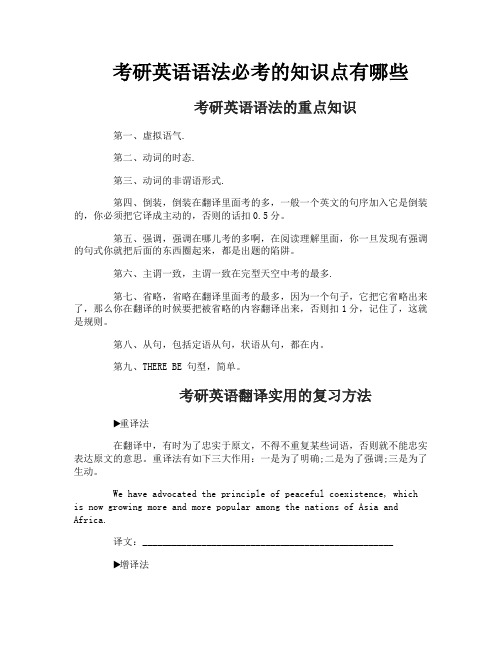
考研英语语法必考的知识点有哪些考研英语语法的重点知识第一、虚拟语气.第二、动词的时态.第三、动词的非谓语形式.第四、倒装,倒装在翻译里面考的多,一般一个英文的句序加入它是倒装的,你必须把它译成主动的,否则的话扣0.5分。
第五、强调,强调在哪儿考的多啊,在阅读理解里面,你一旦发现有强调的句式你就把后面的东西圈起来,都是出题的陷阱。
第六、主谓一致,主谓一致在完型天空中考的最多.第七、省略,省略在翻译里面考的最多,因为一个句子,它把它省略出来了,那么你在翻译的时候要把被省略的内容翻译出来,否则扣1分,记住了,这就是规则。
第八、从句,包括定语从句,状语从句,都在内。
第九、THERE BE 句型,简单。
考研英语翻译实用的复习方法▶重译法在翻译中,有时为了忠实于原文,不得不重复某些词语,否则就不能忠实表达原文的意思。
重译法有如下三大作用:一是为了明确;二是为了强调;三是为了生动。
We have advocated the principle of peaceful coexistence, which is now growing more and more popular among the nations of Asia and Africa.译文:___________________________________________________▶增译法为了使译文忠实地表达原文的意思与风格并使译文合乎表达习惯,必须增加一些词语。
A new kind aircraft-small, cheap, pilotless -is attracting increasing attention.译文:___________________________________________________▶减译法和其他一切事物一样,翻译也是有增必有减。
理解了增译法之后也就明白了减译法,它是增译法的反面。
These developing countries cover vast territories, encompass a large population and abound in natural resources.译文:___________________________________________________▶词类转译法在翻译时,由于两种语言在语法和习惯表达上的差异,在保证原文意思不变的情况下,译文必须改变词类,这就是词类转译法,这种方法不仅指词类的改变,而且还包括词类作用的改变和一定词序的变化。
考研英语语法语态解析大全

考研英语语法语态解析大全1)动词不定式一般式表示的动作与谓语动词表示的动作同时发生,考研英语:语法大全(动词不定式语态用法)。
如:I saw him go out.我看见他出去了。
(saw与go out两个动作同时发生)Would you help me put things in order before we leave?在我们离开之前,你帮我整理一下东西好吗?(would help和put同时发生)2)但在很多情况下,动词不定式一般式表示的动作发生在谓语动词表示的动作之后;如:I hope to see you again.我希望再见到你。
(to see这个动作发生在hope之后)The boy said he wanted to be a scientist.这男孩说他想做一个科学家。
(to be在wanted之后)动词不定式的时态形式动词不定式通常有三种时态形式,现以write为例:一般式to write进行式to be writing完成式to have written动词不定式完成式的用法动词不定式完成式表示的动作发生在限定动词表示的动作之前。
如:I am sorry to have kept you waiting.对不起,叫你久等了。
(to have kept发生在am所表示的.时间之前)She seems to have read the book before.她好像看过这本书。
(to have read发生在seems所表示的时间之前)The battery appears to have run down.这组电池好像已经用完了。
(to have run down发生在appears所表示的时间之前)但在下面句子中,动词不定式表示“动作没有完成”:We were to have met at ten.我们本来是约定十点钟见面的,考研英语《考研英语:语法大全(动词不定式语态用法)》。
考研英语基础十二大语法体系(全)

考研英语十二大基础语法体系一、英语动词的时态英语动词的形式:英语的时态是通过动词的变化来体现的。
因此,了解动词的形式及其变化规律非常重要。
英语的实义动词有以下五种形式:(1)动词原形:动词原形在句子中形式不变。
主要用于主语为非第三人称单数的一般现在时,情态动词之后,或根据语法规定必须用动词原形的其他情况。
(2) 一般现在时第三人称单数形式(简称现单三):主要用于主语为第三人称单数的一般现在时。
(3) 过去式:主要用于一般过去时。
(4) 现在分词:主要用于进行时态,或语法规定的其他情况。
(5) 过去分词:主要用于完成时态,或语法规定的其他情况。
动词一般现在时第三人称单数(现单三)的构成:一般加-s,在ch, sh, s, x 或元音字母o后面加-es,以辅音字母加y结尾的词,变y为i再加-es动词过去式和过去分词,大多数是动词原形+ ed 构成,这是规则动词。
不规则动词的过去式和过去分词有其特殊变化形式,需要个别记忆。
现在分词一律由动词原形加-ing构成:一般加-ing,以不发音的e结尾的词,去掉e,再加-ing,以一个辅音字母(x除外)词尾的重读闭音节词,先双写词尾的辅音字母,再加-ing,以-ie结尾的词,变ie为y,再加-ing。
把时间分为四个阶段:“现在、过去、将来、过去将来”。
英语动词所表示的动作在以上每个时间段中分别有四种状态:一般、进行、完成和完成进行。
因此我们便有了四四一十六个时态。
“时态”就是通过动词的形态变化,来表达动作发生的时间(现在、过去、将来、过去将来)及所处的状态(一般、进行、完成、完成进行)。
比如在“They are doing their exercises.”这个句子中,动词由原形do 变成are doing 的形态,说明这个事情是发生在现在、并处于正在进行的状态当中,所以叫现在进行时;在“They have done their exercises.”这句中,动词由原形do 变成have done的形态,说明这个事情是发生在现在、并处于完成的状态,所以叫现在完成时;在“They always do their exercises.”中,动词用原形do 的形态,说明这个事情是发生在现在、并且是一般情况下永远如此,所以叫一般现在时。
疯狂英语突破系列之语法
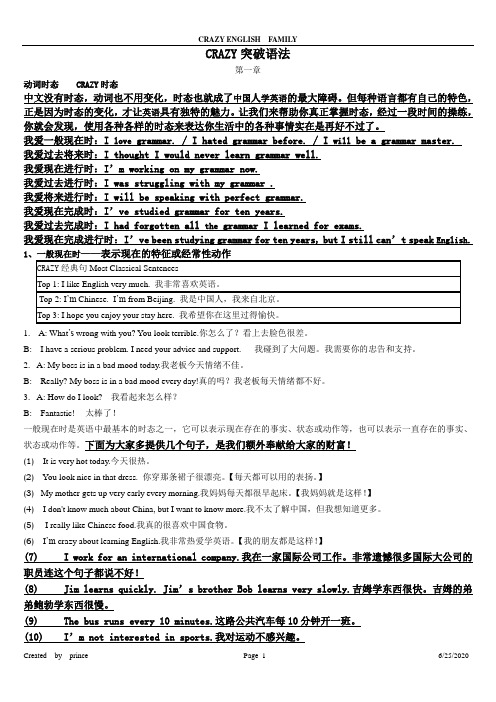
CRAZY突破语法第一章动词时态 CRAZY时态中文没有时态,动词也不用变化,时态也就成了中国人学英语的最大障碍。
但每种语言都有自己的特色,正是因为时态的变化,才让英语具有独特的魅力。
让我们来帮助你真正掌握时态,经过一段时间的操练,你就会发现,使用各种各样的时态来表达你生活中的各种事情实在是再好不过了。
我爱一般现在时:I love grammar. / I hated grammar before. / I will be a grammar master. 我爱过去将来时:I thought I would never learn grammar well.我爱现在进行时:I’m working on my grammar now.我爱过去进行时:I was struggling with my grammar .我爱将来进行时:I will be speaking with perfect grammar.我爱现在完成时:I’ve studied grammar for ten years.我爱过去完成时:I had forgotten all the grammar I learned for exams.我爱现在完成进行时:I’ve been studying grammar for ten years, but I still can’t speak English. 11. A: What’s wrong with you? You look terrible.你怎么了?看上去脸色很差。
B: I have a serious problem. I need your advice and support. 我碰到了大问题。
我需要你的忠告和支持。
2. A: My boss is in a bad mood today.我老板今天情绪不佳。
B: Really? My boss is in a bad mood every day!真的吗?我老板每天情绪都不好。
考研英语常用时态

考研英语常用时态考研英语中,常用的时态包括过去时、现在时和将来时。
合理运用时态是正确表达观点和阐述观点的关键。
以下是常用的考研英语时态:1.一般现在时(Simple Present):描述客观事实、习惯性动作、科学事实等。
Water boils at 100 degrees Celsius.2.现在进行时(Present Continuous):描述正在进行的动作或当前的状况。
I am studying for the exam.3.一般过去时(Simple Past):描述过去的完成动作或状态。
She finished her homework last night.4.过去进行时(Past Continuous):描述在过去某一时刻正在进行的动作。
I was reading a book when the phone rang.5.一般将来时(Simple Future):描述将来发生的动作或事件。
I will call you tomorrow.6.将来进行时(Future Continuous):描述将来某一时刻正在进行的动作。
At this time tomorrow, I will be giving a presentation.7.现在完成时(Present Perfect):描述过去某时开始,持续到现在的动作或状态。
I have lived in this city for five years.8.过去完成时(Past Perfect):描述过去某一时刻之前已经完成的动作或状态。
When I arrived, they had already left.9.将来完成时(Future Perfect):描述将来某一时刻之前将会完成的动作。
By this time next year, I will have graduated.在考研英语写作和阅读理解中,时态的正确使用有助于准确表达观点和理解文章。
英语动词时态和语态知识点总结

英语动词时态和语态知识点总结
英语动词时态和语态是学习英语中非常重要的部分,以下是关于这两部分的知识点总结:
动词时态:
1. 现在简单时(Simple Present Tense):表示现在的习惯或经常发生的动作。
2. 过去简单时(Simple Past Tense):表示过去发生的动作。
3. 现在进行时(Present Continuous Tense):表示正在进行的动作或当前的状态。
4. 过去进行时(Past Continuous Tense):表示过去某个时间正在进行的动作。
5. 现在完成时(Present Perfect Tense):表示已经完成的动作,并对现在有影响。
6. 过去完成时(Past Perfect Tense):表示在过去某个时间之前已经完成的动作。
7. 将来简单时(Simple Future Tense):表示将来的动作。
8. 将来进行时(Future Continuous Tense):表示将来正在进行的动作。
9. 将来完成时(Future Perfect Tense):表示将来某个时间之前已经完成的动作。
动词语态:
1. 主动语态(Active Voice):主语执行谓语的动作。
2. 被动语态(Passive Voice):主语接受谓语的动作。
通过理解并掌握这些基本概念,可以帮助更好地理解和使用英语动词,提高英语表达能力。
黑龙江省考研外国语学科复习资料语法重点知识点总结

黑龙江省考研外国语学科复习资料语法重点知识点总结外国语学科复习在考研备考中占据重要的地位。
语法是外语学习的基础,掌握好语法的重点知识点对于考研复习非常关键。
本文将针对黑龙江省考研外国语学科复习资料中的语法重点知识点进行总结,并提供一些复习建议。
一、时态(1)一般现在时:表示现在或经常性的行为、事实、真理(2)一般过去时:表示过去的行为或状态(3)现在进行时:表示现在正在进行的动作(4)过去进行时:表示过去某个时间进行的动作(5)现在完成时:表示过去发生的事情对现在的影响或结果(6)过去完成时:表示过去某一动作或状态在过去某一时间发生或结束之前已经发生或存在(7)将来时:表示将来某个时间里将要发生的动作或存在的状态二、语态(1)被动语态:表示主语是动作的承受者(2)进行时的被动语态:表示主语在进行某个动作时是被动的三、句子类型(1)陈述句:陈述一个事实或状态,常使用陈述句式即主语+谓语+宾语(2)疑问句:用来询问信息,常使用疑问句式即助动词/情态动词/疑问代词/疑问副词+主语+谓语+宾语/其他成分(3)祈使句:用来表示请求、命令等,常使用祈使句式即谓语四、从句(1)定语从句:修饰名词或代词的从句,常使用关系代词或关系副词引导(2)宾语从句:作为动词的宾语的从句,常使用连词如that, whether, if引导(3)状语从句:作为句子的状语的从句,常使用连词如when, while, as, since, because引导(4)主语从句:作为句子主语的从句,常使用连词如that, whether, if引导五、连接词(1)并列连词:表示并且、或者、但是的词语,常使用and, or, but 等(2)转折连词:表示相反、转折关系的词语,常使用however, but 等(3)因果连词:表示原因和结果的词语,常使用because, so等(4)条件连词:表示条件关系的词语,常使用if, unless等(5)时间连词:表示时间关系的词语,常使用when, while, as等总结:复习外国语学科的语法重点知识点是考研备考的重要任务之一。
- 1、下载文档前请自行甄别文档内容的完整性,平台不提供额外的编辑、内容补充、找答案等附加服务。
- 2、"仅部分预览"的文档,不可在线预览部分如存在完整性等问题,可反馈申请退款(可完整预览的文档不适用该条件!)。
- 3、如文档侵犯您的权益,请联系客服反馈,我们会尽快为您处理(人工客服工作时间:9:00-18:30)。
考研英语必备:时态、语法全突破来源:网络作者:复习指导发表日期:2006-8-26 9:01:31 阅读次数:17709 查看权限:普通文章时态、语态需要掌握的要点:1.以下几类动词一般不能用于进行时,同样不用于完成进行时:(1)表示感知的动词:hear, feel, notice, recognize, see, taste, smell;(2)表示意愿、情感的动词:desire, dislike, forgive, hate, like, love, prefer, refuse, wan t, wish, fear, love, hate;(3)表示思考、看法的动词:believe, doubt, expect, forget, hope, feel, mean, know, agree, realize, mind, recall, recollect, remember, trust, suppose;(4)表示所有、占有的动词:belong to, owe, own, possess, hold(容纳);(5)其他动词:cost, appear, concern, contain, consist, deserve, matter, seem.如:I‘d say whenever you are going after something that is belonging to you, anyone who is depriving you of the right to have it is criminal.(1997年考研题, belong表示归属,不用于进行式)He was seeing somebody creeping into the house through the open window last night.(1990年考研题,see表示结果,不用于进行式)2. 不用will/shall表达将来时的形式:(1)be going to表示现在的打算和意图;(2)arrive, come, drive, go, leave, retire, return, set off, start, take off等表示移位的动词的进行体表示按计划肯定要发生的将来动作;(3)be to (do)表示安排、计划、决定、命令或注定要发生的事,如:Greater efforts to increase agricultural production must be made if food shortage is to be avoide d.(4)be about to (do)表示将要(做),如:Marlin is a young man of independent thinking who is not about to pay compliments to his politica l leaders.(5)be on the point /verge of (doing)表示“马上就要”,一般不与表示将来的时间状语连用;(6)be, begin, come, depart, get off, go, leave, return, start的一般现在时表示按日历或时刻表要发生的将来动作或事件,如:If you want your film to be properly processed, you‘ll have to wait and pick it up on Friday, w hich is the day after tomorrow.</P< p>(画线部分一般不用will be)(7)在时间、条件、让步从句中,一般现在时代替将来时,但要注意区别从句的类型,如:I don‘t know where he will go tomorrow. 我不知道他明天去哪儿。
(宾语从句)I‘ll tell him when you will ring again. 我告诉他你什么时候再来电话。
(宾语从句)比较:I‘ll tell him when you ring again.你再打电话时我告诉他。
(状语从句)(8)在make sure, make certain, see (to it)后的that从句中,谓语动词用一般现在时代替将来时,如:See to it that you include in the paper whatever questions they didn‘t know the answer to last time.(include 不能用will include或其他形式)3.完成时是时态测试的重点,注意与完成时连用的句型和时间状语:(1)by/between/up to/till +过去时间、since、by the time/when +表示过去发生情况的从句,主句用过去完成时。
如:We had just had our breakfast when an old man came to the door.Between 1897 and 1919 at least 29 motion pictures in which artificial be ings were portrayed had been produced.(表示1919年时已发生的情况)(2)by +将来时间、by the time/ when +谓语动词是一般现在时的从句,主句用将来完成时。
如:By the time you arrive in London, we will have stayed in Europe for two weeks.I hope her health will have improved greatly by the time we come back ne xt year.(3)by now、since +过去时间、in/during/for/over/the past/last few(或具体数字)years/days/months,主句用现在完成时,但在it is +具体时间since/before 这一句型中,主句更多的时候不用完成时。
如:The changes that howe taken place place in air travel during the last si xty years would have seemed completely impossible to even the most brilliant sc ientists at the turn of the 19th century.It is four years since John left school.(4)在It is the +序数词/形容词最高级+that的定语从句中,谓语动词常用现在完成时。
如:</P< p>It isn‘t the first time that I have found myself in an embarrassing situation.(5)在no sooner…than…, hardly/scarcely…when/before…句型中,主句常用过去完成时。
(6)其他与完成时连用的时间状语:all this while, all this year, for so me time, so far, already, before, just, long, yet等。
4.完成进行时指动作在完成时的基础上还要继续下去。
如:The company has been promising a rise in salary for ages, but nothing h as happened.The school board listened quietly as John read the demand that his follo wers had been demonstrating for.时态、语态答题思路:(1)先根据选项的区别点确定考题要点为时态,然后回到题句中寻找给出的或暗示的时间状语,缩小选择范围,进而选出正确答案;(2)根据谓语动词与句子主语或非谓语动词与其逻辑主语的关系,确定句子是主动语态还是被动语态。
不定式1.不定式做主语(1)做形式主语的代词:不定式做主语,通常用it充当形式主语,把做主语的不定式短语后置。
如:It took me only five minutes to finish the job.To be frank, it is a great relief to have the task fulfilled in so shor t a time.(2)引导逻辑主语的介词:不定式的逻辑主语一般由介词for引导,但下列表示人的性格行为特征的形容词做表语时,不定式的逻辑主语则由of引导:absurd, bold, brave, courageous, careful, careless, clever, wise, foolish, silly, stupid, good, nice, kind, thoughtful, considerate, gre edy, generous, honest, modest, polite, rude, cruel, selfish, lazy, wic ked, wrong.如:Experts say walking is one of the best ways for a person to stay health y.It‘s clever of you to have invented such a device.(3)不定式做主语补足语:掌握常用不定式做主语补足语的句型。
注意不定式表示的动作发生的时间,并采用相应形式。
如:saidreportedthoughtbe to do sth.believedknownsupposedByron is said to have lived on vinegar and potatoes.The bank is reported in the local newspaper to have been robbed in broad daylight yesterday.2.不定式做宾语(1)必须接不定式做宾语的动词:掌握要求接不定式做宾语的动词:agree, afford, aim, arrange, appear, ask, attempt, choose, claim, decide, desire, determine, expect, fail, guarantee, hope, endeavor, in tend, long, mean, manage, offer, ought, plan, pledge, pretend, prepare, promise, proceed, prove, resolve, refuse, request, swear, tend, try,venture, wait, wish.如:Even though the children pretended to be asleep, the nurses were not de ceived when they came into the room.注意:1)有的动词要求特殊疑问词+不定式做宾语,这类动词有:consider, discover, explain, forget, guess, know, learn, observe, remember, see, tell, understand, wonder,如:While still a young boy, Bizet knew how to play the piano well and as h e grew older, he wrote operas, the most famous of which is Carmen.2)如果该特殊疑问词在不定式中做介词宾语,介词往往置于该特殊疑问词的前面。
